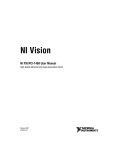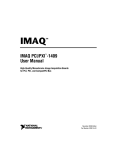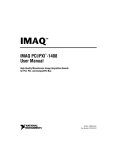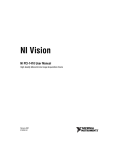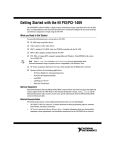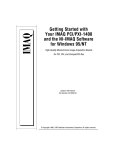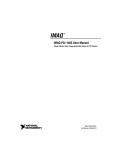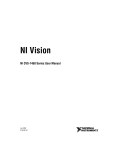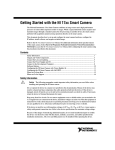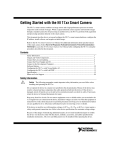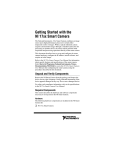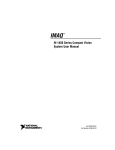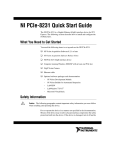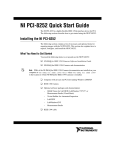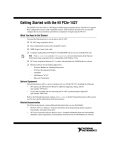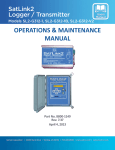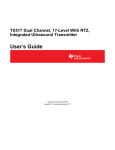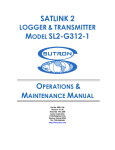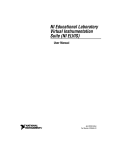Download IMAQTM IMAQ PCI-1410 User Manual
Transcript
IMAQ TM IMAQ PCI-1410 User Manual High-Quality Monochrome Image Acquisition Device for PCI Chassis IMAQ PCI-1410 User Manual January 2005 373793B-01 Support Worldwide Technical Support and Product Information ni.com National Instruments Corporate Headquarters 11500 North Mopac Expressway Austin, Texas 78759-3504 USA Tel: 512 683 0100 Worldwide Offices Australia 1800 300 800, Austria 43 0 662 45 79 90 0, Belgium 32 0 2 757 00 20, Brazil 55 11 3262 3599, Canada (Calgary) 403 274 9391, Canada (Ottawa) 613 233 5949, Canada (Québec) 450 510 3055, Canada (Toronto) 905 785 0085, Canada (Vancouver) 604 685 7530, China 86 21 6555 7838, Czech Republic 420 224 235 774, Denmark 45 45 76 26 00, Finland 385 0 9 725 725 11, France 33 0 1 48 14 24 24, Germany 49 0 89 741 31 30, India 91 80 51190000, Israel 972 0 3 6393737, Italy 39 02 413091, Japan 81 3 5472 2970, Korea 82 02 3451 3400, Malaysia 603 9131 0918, Mexico 01 800 010 0793, Netherlands 31 0 348 433 466, New Zealand 0800 553 322, Norway 47 0 66 90 76 60, Poland 48 22 3390150, Portugal 351 210 311 210, Russia 7 095 783 68 51, Singapore 65 6226 5886, Slovenia 386 3 425 4200, South Africa 27 0 11 805 8197, Spain 34 91 640 0085, Sweden 46 0 8 587 895 00, Switzerland 41 56 200 51 51, Taiwan 886 2 2528 7227, Thailand 662 992 7519, United Kingdom 44 0 1635 523545 For further support information, refer to the Technical Support and Professional Services appendix. To comment on National Instruments documentation, refer to the National Instruments Web site at ni.com/info and enter the info code feedback. © 2004–2005 National Instruments Corporation. All rights reserved. Important Information Warranty The IMAQ PCI-1410 is warranted against defects in materials and workmanship for a period of one year from the date of shipment, as evidenced by receipts or other documentation. National Instruments will, at its option, repair or replace equipment that proves to be defective during the warranty period. This warranty includes parts and labor. The media on which you receive National Instruments software are warranted not to fail to execute programming instructions, due to defects in materials and workmanship, for a period of 90 days from date of shipment, as evidenced by receipts or other documentation. National Instruments will, at its option, repair or replace software media that do not execute programming instructions if National Instruments receives notice of such defects during the warranty period. National Instruments does not warrant that the operation of the software shall be uninterrupted or error free. A Return Material Authorization (RMA) number must be obtained from the factory and clearly marked on the outside of the package before any equipment will be accepted for warranty work. National Instruments will pay the shipping costs of returning to the owner parts which are covered by warranty. National Instruments believes that the information in this document is accurate. The document has been carefully reviewed for technical accuracy. In the event that technical or typographical errors exist, National Instruments reserves the right to make changes to subsequent editions of this document without prior notice to holders of this edition. The reader should consult National Instruments if errors are suspected. In no event shall National Instruments be liable for any damages arising out of or related to this document or the information contained in it. EXCEPT AS SPECIFIED HEREIN, NATIONAL INSTRUMENTS MAKES NO WARRANTIES, EXPRESS OR IMPLIED, AND SPECIFICALLY DISCLAIMS ANY WARRANTY OF MERCHANTABILITY OR FITNESS FOR A PARTICULAR PURPOSE. CUSTOMER’S RIGHT TO RECOVER DAMAGES CAUSED BY FAULT OR NEGLIGENCE ON THE PART OF NATIONAL INSTRUMENTS SHALL BE LIMITED TO THE AMOUNT THERETOFORE PAID BY THE CUSTOMER. NATIONAL INSTRUMENTS WILL NOT BE LIABLE FOR DAMAGES RESULTING FROM LOSS OF DATA, PROFITS, USE OF PRODUCTS, OR INCIDENTAL OR CONSEQUENTIAL DAMAGES, EVEN IF ADVISED OF THE POSSIBILITY THEREOF. This limitation of the liability of National Instruments will apply regardless of the form of action, whether in contract or tort, including negligence. Any action against National Instruments must be brought within one year after the cause of action accrues. National Instruments shall not be liable for any delay in performance due to causes beyond its reasonable control. The warranty provided herein does not cover damages, defects, malfunctions, or service failures caused by owner’s failure to follow the National Instruments installation, operation, or maintenance instructions; owner’s modification of the product; owner’s abuse, misuse, or negligent acts; and power failure or surges, fire, flood, accident, actions of third parties, or other events outside reasonable control. Copyright Under the copyright laws, this publication may not be reproduced or transmitted in any form, electronic or mechanical, including photocopying, recording, storing in an information retrieval system, or translating, in whole or in part, without the prior written consent of National Instruments Corporation. Trademarks National Instruments, NI, ni.com, and LabVIEW are trademarks of National Instruments Corporation. Refer to the Terms of Use section on ni.com/legal for more information about National Instruments trademarks. Other product and company names mentioned herein are trademarks or trade names of their respective companies. Members of the National Instruments Alliance Partner Program are business entities independent from National Instruments and have no agency, partnership, or joint-venture relationship with National Instruments. Patents For patents covering National Instruments products, refer to the appropriate location: Help»Patents in your software, the patents.txt file on your CD, or ni.com/patents. WARNING REGARDING USE OF NATIONAL INSTRUMENTS PRODUCTS (1) NATIONAL INSTRUMENTS PRODUCTS ARE NOT DESIGNED WITH COMPONENTS AND TESTING FOR A LEVEL OF RELIABILITY SUITABLE FOR USE IN OR IN CONNECTION WITH SURGICAL IMPLANTS OR AS CRITICAL COMPONENTS IN ANY LIFE SUPPORT SYSTEMS WHOSE FAILURE TO PERFORM CAN REASONABLY BE EXPECTED TO CAUSE SIGNIFICANT INJURY TO A HUMAN. (2) IN ANY APPLICATION, INCLUDING THE ABOVE, RELIABILITY OF OPERATION OF THE SOFTWARE PRODUCTS CAN BE IMPAIRED BY ADVERSE FACTORS, INCLUDING BUT NOT LIMITED TO FLUCTUATIONS IN ELECTRICAL POWER SUPPLY, COMPUTER HARDWARE MALFUNCTIONS, COMPUTER OPERATING SYSTEM SOFTWARE FITNESS, FITNESS OF COMPILERS AND DEVELOPMENT SOFTWARE USED TO DEVELOP AN APPLICATION, INSTALLATION ERRORS, SOFTWARE AND HARDWARE COMPATIBILITY PROBLEMS, MALFUNCTIONS OR FAILURES OF ELECTRONIC MONITORING OR CONTROL DEVICES, TRANSIENT FAILURES OF ELECTRONIC SYSTEMS (HARDWARE AND/OR SOFTWARE), UNANTICIPATED USES OR MISUSES, OR ERRORS ON THE PART OF THE USER OR APPLICATIONS DESIGNER (ADVERSE FACTORS SUCH AS THESE ARE HEREAFTER COLLECTIVELY TERMED “SYSTEM FAILURES”). ANY APPLICATION WHERE A SYSTEM FAILURE WOULD CREATE A RISK OF HARM TO PROPERTY OR PERSONS (INCLUDING THE RISK OF BODILY INJURY AND DEATH) SHOULD NOT BE RELIANT SOLELY UPON ONE FORM OF ELECTRONIC SYSTEM DUE TO THE RISK OF SYSTEM FAILURE. TO AVOID DAMAGE, INJURY, OR DEATH, THE USER OR APPLICATION DESIGNER MUST TAKE REASONABLY PRUDENT STEPS TO PROTECT AGAINST SYSTEM FAILURES, INCLUDING BUT NOT LIMITED TO BACK-UP OR SHUT DOWN MECHANISMS. BECAUSE EACH END-USER SYSTEM IS CUSTOMIZED AND DIFFERS FROM NATIONAL INSTRUMENTS' TESTING PLATFORMS AND BECAUSE A USER OR APPLICATION DESIGNER MAY USE NATIONAL INSTRUMENTS PRODUCTS IN COMBINATION WITH OTHER PRODUCTS IN A MANNER NOT EVALUATED OR CONTEMPLATED BY NATIONAL INSTRUMENTS, THE USER OR APPLICATION DESIGNER IS ULTIMATELY RESPONSIBLE FOR VERIFYING AND VALIDATING THE SUITABILITY OF NATIONAL INSTRUMENTS PRODUCTS WHENEVER NATIONAL INSTRUMENTS PRODUCTS ARE INCORPORATED IN A SYSTEM OR APPLICATION, INCLUDING, WITHOUT LIMITATION, THE APPROPRIATE DESIGN, PROCESS AND SAFETY LEVEL OF SUCH SYSTEM OR APPLICATION. Compliance Compliance with FCC/Canada Radio Frequency Interference Regulations Determining FCC Class The Federal Communications Commission (FCC) has rules to protect wireless communications from interference. The FCC places digital electronics into two classes. These classes are known as Class A (for use in industrial-commercial locations only) or Class B (for use in residential or commercial locations). All National Instruments (NI) products are FCC Class A products. Depending on where it is operated, this Class A product could be subject to restrictions in the FCC rules. (In Canada, the Department of Communications (DOC), of Industry Canada, regulates wireless interference in much the same way.) Digital electronics emit weak signals during normal operation that can affect radio, television, or other wireless products. All Class A products display a simple warning statement of one paragraph in length regarding interference and undesired operation. The FCC rules have restrictions regarding the locations where FCC Class A products can be operated. Consult the FCC Web site at www.fcc.gov for more information. FCC/DOC Warnings This equipment generates and uses radio frequency energy and, if not installed and used in strict accordance with the instructions in this manual and the CE marking Declaration of Conformity*, may cause interference to radio and television reception. Classification requirements are the same for the Federal Communications Commission (FCC) and the Canadian Department of Communications (DOC). Changes or modifications not expressly approved by NI could void the user’s authority to operate the equipment under the FCC Rules. Class A Federal Communications Commission This equipment has been tested and found to comply with the limits for a Class A digital device, pursuant to part 15 of the FCC Rules. These limits are designed to provide reasonable protection against harmful interference when the equipment is operated in a commercial environment. This equipment generates, uses, and can radiate radio frequency energy and, if not installed and used in accordance with the instruction manual, may cause harmful interference to radio communications. Operation of this equipment in a residential area is likely to cause harmful interference in which case the user is required to correct the interference at their own expense. Canadian Department of Communications This Class A digital apparatus meets all requirements of the Canadian Interference-Causing Equipment Regulations. Cet appareil numérique de la classe A respecte toutes les exigences du Règlement sur le matériel brouilleur du Canada. Compliance with EU Directives Users in the European Union (EU) should refer to the Declaration of Conformity (DoC) for information* pertaining to the CE marking. Refer to the Declaration of Conformity (DoC) for this product for any additional regulatory compliance information. To obtain the DoC for this product, visit ni.com/certification, search by model number or product line, and click the appropriate link in the Certification column. * The CE marking Declaration of Conformity contains important supplementary information and instructions for the user or installer. Conventions The following conventions are used in this manual: <> Angle brackets that contain numbers separated by an ellipsis represent a range of values associated with a bit or signal name—for example, DIO<3..0>. » The » symbol leads you through nested menu items and dialog box options to a final action. The sequence File»Page Setup»Options directs you to pull down the File menu, select the Page Setup item, and select Options from the last dialog box. This icon denotes a note, which alerts you to important information. This icon denotes a caution, which advises you of precautions to take to avoid injury, data loss, or a system crash. bold Bold text denotes items that you must select or click in the software, such as menu items and dialog box options. Bold text also denotes parameter names. italic Italic text denotes variables, emphasis, a cross reference, or an introduction to a key concept. This font also denotes text that is a placeholder for a word or value that you must supply. monospace Text in this font denotes text or characters that you should enter from the keyboard, sections of code, programming examples, and syntax examples. This font is also used for the proper names of disk drives, paths, directories, programs, subprograms, subroutines, device names, functions, operations, variables, filenames, and extensions. Contents Chapter 1 Introduction About the IMAQ 1410 Device.......................................................................................1-1 Software Overview ........................................................................................................1-2 NI-IMAQ Driver Software ..............................................................................1-3 National Instruments Application Software ....................................................1-3 Vision Builder for Automated Inspection.........................................1-3 Vision Development Module ............................................................1-4 Integration with DAQ......................................................................................1-4 Vision and Motion...........................................................................................1-5 Chapter 2 Installation Necessary Items .............................................................................................................2-1 Optional Equipment .......................................................................................................2-2 Unpacking ......................................................................................................................2-2 Safety Information .........................................................................................................2-2 Installation .....................................................................................................................2-5 IMAQ 1410 Device .........................................................................................2-5 Chapter 3 Hardware Overview Functional Overview......................................................................................................3-1 Video Multiplexer ...........................................................................................3-2 Programmable Gain and Offset .......................................................................3-2 Analog Bandwidth Control Circuitry ..............................................................3-2 10-Bit ADC .....................................................................................................3-3 Digital Filter and LUT.....................................................................................3-3 Onboard Memory ............................................................................................3-3 Scatter-Gather DMA Controllers ....................................................................3-3 PCI Interface....................................................................................................3-3 Genlock Circuit and SYNC Mux ....................................................................3-3 Acquisition and Region-of-Interest Control....................................................3-4 RTSI Bus .........................................................................................................3-4 Digital Input/Output Circuitry.........................................................................3-4 © National Instruments Corporation vii IMAQ PCI-1410 User Manual Contents Acquisition Modes......................................................................................................... 3-4 Analog Front End Considerations ................................................................................. 3-5 10-Bit/8-Bit Mode........................................................................................... 3-5 Clamping......................................................................................................... 3-6 Chapter 4 Signal Connections Video Input Channels .................................................................................................... 4-1 BNC Connector ............................................................................................................. 4-1 Digital I/O Connector .................................................................................................... 4-2 Digital I/O Connector Signal Connection Descriptions.................................. 4-3 Appendix A Specifications Appendix B Custom Cables Appendix C Technical Support and Professional Services Glossary Index IMAQ PCI-1410 User Manual viii ni.com 1 Introduction This chapter describes the IMAQ PCI-1410 device and its software programming options. About the IMAQ 1410 Device The IMAQ 1410 is a high-accuracy, monochrome image acquisition (IMAQ) device for PCI that supports RS-170, CCIR, NTSC, and PAL video standards, as well as nonstandard cameras from any of four input sources. The IMAQ 1410 features a 10-bit analog-to-digital converter (ADC) that converts video signals to digital formats. The IMAQ 1410 acquires images in real time and stores them in onboard frame memory or transfers them directly to system memory. The IMAQ 1410 is easy to install and configure. It ships with NI-IMAQ, the National Instruments driver software you can use to directly control the IMAQ 1410 and other National Instruments IMAQ devices. With NI-IMAQ, you can quickly and easily start the applications without having to program the device at the register level. As a stand-alone device, the IMAQ 1410 supports four general-purpose control lines that are configurable to generate precise timing signals for controlling camera acquisition. The IMAQ 1410 also supports four video sources and four external I/O lines to use as triggers or digital I/O lines. Easily synchronizing several functions to a common trigger or timing event is a common challenge with image acquisition devices. The IMAQ 1410 uses its Real-Time System Integration (RTSI) bus to solve this problem. The RTSI bus uses the National Instruments RTSI bus interface and ribbon cable to route additional timing and trigger signals between the IMAQ 1410 and National Instruments DAQ, Motion Control, or other IMAQ devices. The RTSI bus can even synchronize multiple IMAQ hardware captures. For detailed IMAQ 1410 specifications, refer to Appendix A, Specifications. Refer to Figure 1-1 for the location of the IMAQ 1410 W1 jumper and the connectors discussed in this manual. © National Instruments Corporation 1-1 IMAQ PCI-1410 User Manual Chapter 1 Introduction NATIONAL INSTRUMENTS 4 3 IMAQ PCI-1410 © COPYRIGHT 2004 2 1 1 2 68-Pin VHDCI Connector BNC Connector 3 4 W1 Jumper RTSI Bus Connector Figure 1-1. IMAQ PCI-1410 Parts Locator Diagram Software Overview Programming the IMAQ 1410 requires the NI-IMAQ driver software for controlling the hardware. National Instruments also offers the following application software packages for analyzing and processing your acquired images. • Vision Builder for Automated Inspection (AI)—Allows you to configure solutions to common inspection tasks. • National Instruments Vision Development Module—Provides customized control over hardware and algorithms. The following sections provide an overview of the driver software and the application software. For detailed information about individual software packages, refer to the documentation specific to each package. IMAQ PCI-1410 User Manual 1-2 ni.com Chapter 1 Introduction NI-IMAQ Driver Software The NI-IMAQ driver software ships with the IMAQ 1410. NI-IMAQ has an extensive library of functions—such as routines for video configuration, continuous and single shot image acquisition, memory buffer allocation, trigger control, and device configuration—you can call from the application development environment (ADE). NI-IMAQ handles many of the complex issues between the computer and the IMAQ device, such as programming interrupts and camera control. NI-IMAQ performs all functions required for acquiring and saving images but does not perform image analysis. For image analysis functionality, refer to the National Instruments Application Software section of this chapter. NI-IMAQ is also the interface path between the IMAQ 1410 and LabVIEW, LabWindows™/CVI™, or a text-based programming environment. The NI-IMAQ software kit includes a series of libraries for image acquisition for LabVIEW, LabWindows/CVI, and Measurement Studio, which contains libraries for Microsoft Visual Basic. NI-IMAQ features both high-level and low-level functions. Examples of high-level functions include the sequences to acquire images in multi-buffer, single-shot, or continuous mode. An example of a low-level function is configuring an image sequence, since it requires advanced understanding of the IMAQ device and image acquisition. National Instruments Application Software This section describes the National Instruments application software packages you can use to analyze and process the images you acquire with the IMAQ 1410. Vision Builder for Automated Inspection NI Vision Builder for Automated Inspection (AI) is configurable machine vision software that you can use to prototype, benchmark, and deploy applications. Vision Builder AI does not require programming, but is scalable to powerful programming environments. Vision Builder AI allows you to easily configure and benchmark a sequence of visual inspection steps, as well as deploy the visual inspection system for automated inspection. With Vision Builder AI, you can perform powerful visual inspection tasks and make decisions based on the results of individual tasks. You also can migrate the configured inspection to LabVIEW, extending the capabilities of the applications if necessary. © National Instruments Corporation 1-3 IMAQ PCI-1410 User Manual Chapter 1 Introduction Vision Builder AI is available for LabVIEW, LabWindows/CVI, and Measurement Studio, which includes support for Microsoft Visual Basic. Vision Development Module The Vision Development Module is an image acquisition, processing, and analysis library of more than 270 functions for the following common machine vision tasks: • Pattern matching • Particle analysis • Gauging • Taking measurements • Grayscale, color, and binary image display You can use the Vision Development Module functions individually or in combination. With the Vision Development Module, you can acquire, display, and store images, as well as perform image analysis, and processing. Using the Vision Development Module, imaging novices and experts can program the most basic or complicated image applications without knowledge of particular algorithm implementations. NI Vision Assistant is included with the Vision Development Module. Vision Assistant is an interactive prototyping tool for machine vision and scientific imaging developers. With Vision Assistant, you can prototype vision applications quickly and test how various vision image processing functions work. Vision Assistant generates a Builder file, which is a text description containing a recipe of the machine vision and image processing functions. This Builder file provides a guide you can use for developing applications in any ADE, such as LabWindows/CVI or Visual Basic, using the Vision Assistant machine vision and image processing libraries. Using the LabVIEW VI creation wizard, Vision Assistant can create LabVIEW VI diagrams that perform the prototype you created in Vision Assistant. You then can use LabVIEW to add functionality to the generated VI. Integration with DAQ Platforms that support NI-IMAQ also support NI-DAQ and a variety of National Instruments DAQ devices. This allows integration between IMAQ devices and National Instruments DAQ products. IMAQ PCI-1410 User Manual 1-4 ni.com Chapter 1 Introduction Vision and Motion Use National Instruments high-performance stepper and servo motion control products with pattern matching software in inspection and guidance applications, such as locating alignment markers on semiconductor wafers, guiding robotic arms, inspecting the quality of manufactured parts, and locating cells. © National Instruments Corporation 1-5 IMAQ PCI-1410 User Manual 2 Installation This chapter contains information about getting started with the IMAQ PCI-1410 device. Necessary Items The following items are necessary for setting up and configuring the IMAQ 1410: ❑ NI-IMAQ driver software and documentation ❑ Getting Started with Your IMAQ System ❑ Optional software packages and documentation: – NI Vision Builder for Automated Inspection – NI Vision Assistant – LabVIEW – LabWindows/CVI – Measurement Studio ❑ IMAQ BNC-1 shielded, 75 Ω BNC cable for VIDEO0, included with the IMAQ 1410 ❑ Video camera or other video source ❑ Pentium-based PCI computer running Windows 2000/NT/XP/Me/98 © National Instruments Corporation 2-1 IMAQ PCI-1410 User Manual Chapter 2 Installation Optional Equipment National Instruments offers the following products for use with the IMAQ 1410: • IMAQ A6822 BNC breakout box and cable for trigger and additional camera support • RTSI bus cables for connecting the IMAQ 1410 to DAQ, Motion Control, and IMAQ hardware • Other National Instruments DAQ devices for enhanced triggering, timing, or input/output For specific information about these products, refer to the National Instruments catalog, visit ni.com, or call the office nearest you. Unpacking The IMAQ 1410 ships in an antistatic package to prevent electrostatic discharge from damaging device components. To avoid such damage in handling the device, take the following precautions: Caution • Ground yourself using a grounding strap or by touching a grounded object, such as the computer chassis. • Touch the antistatic package to a metal part of the computer chassis before removing the device from the package. Never touch the exposed pins of connectors. • Remove the device from the package and inspect it for loose components or any other signs of damage. Notify National Instruments if the device appears damaged in any way. Do not install a damaged device in the computer. Safety Information The following paragraphs contain important safety information you must follow when installing and operating the device. Caution Do not operate the device in a manner not specified in the documentation. Misuse of the device may result in a hazard and may compromise the safety protection built into the device. If the device is damaged, turn it off and do IMAQ PCI-1410 User Manual 2-2 ni.com Chapter 2 Installation not use it until service-trained personnel can check its safety. If necessary, return the device to National Instruments for repair. Keep away from live circuits. Do not remove equipment covers or shields unless you are trained to do so. If signal wires are connected to the device, hazardous voltages can exist even when the equipment is turned off. To avoid a shock hazard, do not perform procedures involving cover or shield removal unless you are qualified to do so. Disconnect all field power prior to removing covers or shields. If the device is rated for use with hazardous voltages (>30 Vrms, 42.4 Vpk, or 60 Vdc), it may require a safety earth-ground connection wire. Refer to the device specifications for maximum voltage ratings. Because of the danger of introducing additional hazards, do not install unauthorized parts or modify the device. Use the device only with the chassis, modules, accessories, and cables specified in the installation instructions. All covers and filler panels must be installed while operating the device. Do not operate the device in an explosive atmosphere or where flammable gases or fumes may be present. Operate the device only at or below the pollution degree stated in the specifications. Pollution consists of any foreign matter—solid, liquid, or gas—that may reduce dielectric strength or surface resistivity. The following is a listing of pollution degrees. • Pollution Degree 1—No pollution or only dry, nonconductive pollution occurs. The pollution has no effect. • Pollution Degree 2—Normally only nonconductive pollution occurs. Occasionally, nonconductive pollution becomes conductive because of condensation. • Pollution Degree 3—Conductive pollution or dry, nonconductive pollution occurs. Nonconductive pollution becomes conductive because of condensation. Clean the device and accessories by brushing off light dust with a soft, nonmetallic brush. Remove other contaminants with a stiff, nonmetallic brush. The unit must be completely dry and free from contaminants before returning it to service. You must insulate signal connections for the maximum voltage for which the device is rated. Do not exceed the maximum ratings for the device. Remove power from signal lines before connection to or disconnection from the device. © National Instruments Corporation 2-3 IMAQ PCI-1410 User Manual Chapter 2 Installation Caution National Instruments measurement products may be classified as either Installation Category I or II. Operate products at or below the Installation Category level specified in the hardware specifications. Installation Category1: Measurement circuits are subjected to working voltages2 and transient stresses (overvoltage) from the circuit to which they are connected during measurement or test. Installation Category establishes standardized impulse withstand voltage levels that commonly occur in electrical distribution systems. The following is a description of Installation (Measurement3) Categories: 1 2 3 4 • Installation Category I is for measurements performed on circuits not directly connected to the electrical distribution system referred to as MAINS4 voltage. This category is for measurements of voltages from specially protected secondary circuits. Such voltage measurements include signal levels, special equipment, limited-energy parts of equipment, circuits powered by regulated low-voltage sources, and electronics. • Installation Category II is for measurements performed on circuits directly connected to the electrical distribution system. This category refers to local-level electrical distribution, such as that provided by a standard wall outlet (e.g., 115 V for U.S. or 230 V for Europe). Examples of Installation Category II are measurements performed on household appliances, portable tools, and similar products. • Installation Category III is for measurements performed in the building installation at the distribution level. This category refers to measurements on hard-wired equipment such as equipment in fixed installations, distribution boards, and circuit breakers. Other examples are wiring, including cables, bus-bars, junction boxes, switches, socket-outlets in the fixed installation, and stationary motors with permanent connections to fixed installations. • Installation Category IV is for measurements performed at the primary electrical supply installation (<1,000 V). Examples include electricity meters and measurements on primary overcurrent protection devices and on ripple control units. Installation Categories as defined in electrical safety standard IEC 61010-1. Working voltage is the highest rms value of an AC or DC voltage that can occur across any particular insulation. Installation Category is also referred to as Measurement Category. MAINS is defined as the (hazardous live) electrical supply system to which equipment is designed to be connected for the purpose of powering the equipment. Suitably rated measuring circuits may be connected to the MAINS for measuring purposes. IMAQ PCI-1410 User Manual 2-4 ni.com Chapter 2 Installation Installation Before getting started, refer to the electrostatic discharge guidelines in the Unpacking section of this chapter. IMAQ 1410 Device Note You must install the NI-IMAQ driver software before installing the IMAQ 1410. Install the IMAQ 1410 in any available PCI expansion slot in the computer. To achieve the best noise performance, leave as much room as possible between the IMAQ 1410 and other devices and hardware. Complete the following steps to install the IMAQ 1410. 1. Verify that the NI-IMAQ driver software is installed on the computer. 2. Verify that the W1 jumper is in place. The IMAQ 1410 ships with this jumper in place. 3. Power off and unplug the computer. To protect both yourself and the computer from electrical hazards, the computer must remain off and unplugged until you finish installing the IMAQ 1410 device. Caution 4. Remove the computer cover. Make sure there are no lit LEDs on the motherboard. If any are lit, wait until they go out before continuing installation. 5. Touch the metal part of the power supply case inside the computer to discharge any static electricity that might be on your clothes or body. 6. Locate the metal bracket that covers the cut-out in the back panel of the chassis for the slot you have selected. Remove and save the bracket-retaining screw and the bracket cover. 7. Line up the IMAQ 1410 card-edge connector with the expansion slot receptacle. Using slow, evenly distributed pressure, press the IMAQ 1410 straight down until it rests firmly in the expansion slot. 8. Reinstall the bracket-retaining screw to secure the IMAQ 1410 to the back panel rail. 9. Visually verify the installation. 10. Replace the computer cover, and plug in the computer. © National Instruments Corporation 2-5 IMAQ PCI-1410 User Manual 3 Hardware Overview This chapter describes the features of the IMAQ PCI-1410 device and includes information about acquisition modes, analog front-end considerations, and clamping. Functional Overview The IMAQ 1410 features a flexible, high-speed data path optimized for the acquisition and formatting of video data from analog cameras. The IMAQ 1410 can acquire from RS-170/NTSC, CCIR/PAL, VGA, and progressive scan cameras, as well as from non-standard cameras such as line scan cameras. The IMAQ 1410 digitizes analog video signals to 8 or 10 bits of resolution at sampling frequencies up to 40 MHz. The IMAQ 1410 has a factory-calibrated gain circuit to improve measurement accuracy and board-to-board consistency. It uses a PCI interface for high-speed data transfer, 16 MB of SDRAM for data buffering, and region-of-interest control circuitry for optimizing the data transfer. The 16 MB of SDRAM also allows you to acquire entire images into onboard memory when necessary. The IMAQ 1410 includes four external triggers, four camera control signals, seven RTSI bus triggers, and four video synchronization signals. © National Instruments Corporation 3-1 IMAQ PCI-1410 User Manual Chapter 3 Hardware Overview The block diagram in Figure 3-1 illustrates the key functional units of the IMAQ 1410. RTSI Bus 4 Camera Control Lines Digital Input/Output Circuitry External PCLK, HSYNC, VSYNC External CSYNC BNC Video 0,1,2,3 Video Mux Aspect Ratio Correction Genlock Circuit and SYNC Mux HSYNC, VSYNC PCLK Acquisition and Region-of-Interest Control PCI Bus 68-pin VHDCI Connector 4 External Triggers Programmable Gain and Offset Video 0 Analog Bandwidth Control Circuitry Digital Filter and LUT 10-Bit ADC Onboard Memory and Control Circuitry PCI Interface and Scatter-Gather DMA Controller Figure 3-1. IMAQ 1410 Block Diagram Video Multiplexer The video multiplexer routes one of the four AC-coupled video inputs to the 10-bit ADC circuitry. The input impedance is 75 Ω. Programmable Gain and Offset The IMAQ 1410 uses programmable gain and offset circuitry to optimize the input signal range. Analog Bandwidth Control Circuitry You can select either the full bandwidth of 30 MHz or a reduced bandwidth of 9 MHz. The 9 MHz bandwidth setting is available using a 5th order Butterworth lowpass filter. IMAQ PCI-1410 User Manual 3-2 ni.com Chapter 3 Hardware Overview 10-Bit ADC The 10-bit ADC digitizes the conditioned video signal. Digital Filter and LUT The digital filter removes chrominance from a composite color video signal that conforms to either PAL or NTSC. The output of the digital filter passes through the 1,024 × 10-bit lookup table (LUT). You can configure the LUT to implement simple imaging operations such as contrast enhancement, data inversion, gamma correction, or other user-defined transfer functions. Onboard Memory The IMAQ 1410 has 16 MB of SDRAM for temporarily storing image data being transferred to the system memory through the PCI bus. The memory can store multiple image buffers. Scatter-Gather DMA Controllers The IMAQ 1410 uses three independent onboard direct memory access (DMA) controllers. The DMA controllers transfer data between the onboard SDRAM memory buffer and the PCI bus. Each of these controllers supports scatter-gather DMA, which allows the controllers to reconfigure on-the-fly. This functionality enables the IMAQ 1410 to perform continuous image transfers directly to either contiguous or fragmented memory buffers. PCI Interface The IMAQ 1410 implements the PCI interface with a National Instruments custom application-specific integrated circuit (ASIC), the PCI MITE. The PCI interface can transfer data at a maximum rate of 132 MB/s in bus master mode. Genlock Circuit and SYNC Mux The genlock circuit receives the incoming video signal and generates PCLK, HSYNC, and VSYNC signals for use by the acquisition and control circuitry. The IMAQ 1410 can lock to the standard RS-170/NTSC and CCIR/PAL video signals as well as progressive scan and VGA (640 × 480 resolution) signals. The genlock circuit on the IMAQ 1410 also can lock to external HSYNC and VSYNC or CSYNC signals, as well as additional nonstandard formats. © National Instruments Corporation 3-3 IMAQ PCI-1410 User Manual Chapter 3 Hardware Overview Acquisition and Region-of-Interest Control The acquisition and region-of-interest (ROI) control circuitry routes the active pixels from the 10-bit ADC to the onboard memory. The IMAQ 1410 can perform ROI and scaling on all video lines. Pixel and line scaling transfers certain multiples (two, four, or eight) of pixels and lines to onboard memory. RTSI Bus The seven trigger lines on the RTSI bus provide a flexible interconnection scheme between multiple IMAQ devices, as well as between National Instruments DAQ or Motion Control devices. Digital Input/Output Circuitry The digital input/output (I/O) circuitry routes, monitors, and drives the external trigger lines, RTSI bus lines, and camera control lines. You can use the trigger lines to start or stop an acquisition on a rising or falling edge. You also can map onboard signals such as HSYNC, VSYNC, ACQUISTION_IN_PROGRESS, and ACQUISITION_DONE to these lines. The camera control lines provide a means to generate deterministic signals for triggering cameras, strobe lights, or other timing-critical applications. Note The IMAQ 1410 does not support pixel clock output on the trigger lines. Acquisition Modes The IMAQ 1410 supports the following four video acquisition modes: IMAQ PCI-1410 User Manual • Standard Mode—In standard mode, the IMAQ 1410 receives an incoming composite video signal from the external BNC or 68-pin VHDCI connector and generates CSYNC, HSYNC, VSYNC, and PCLK signals. The VHDCI connector outputs the generated CSYNC signal to synchronize other IMAQ devices or cameras. • CSYNC External Mode—In CYSNC external mode, the IMAQ 1410 receives an incoming video signal (composite or luminance) and an external CSYNC signal from the external connector and generates HSYNC, VSYNC, and PCLK signals. 3-4 ni.com Chapter 3 Hardware Overview • External Lock Mode—In external lock mode, the IMAQ 1410 receives HSYNC, VSYNC, and PCLK signals from the camera and uses these signals to acquire the video signals directly. You can use this mode to acquire from a line scan camera. • External HSYNC/VSYNC (HLOCK only) Mode—In external HSYNC/VSYNC (HLOCK only) mode, the IMAQ 1410 receives the external HSYNC and VSYNC signals and internally generates the PCLK signal. In this mode, the IMAQ 1410 genlock circuitry uses only the HSYNC signal for locking. You can use this mode to acquire from asynchronously reset cameras that output a continuous HSYNC. Analog Front End Considerations The analog front end of the IMAQ 1410 features a calibrated gain circuit, programmable DC-restore circuit, and 10-bit ADC as shown in Figure 3-2. Analog Video 1 of 4 Gain 10-bit ADC DC-restore Digital Gain Correction, Filtering, and LUT 10- or 8-bit Figure 3-2. IMAQ 1410 Analog Front End 10-Bit/8-Bit Mode The IMAQ 1410 always digitizes the incoming video signal to 10 bits of resolution. In 10-bit mode, the IMAQ 1410 has four fixed, full-scale ranges for calibrating the gain for each range. Because the nominal full-scale ranges are 0.20, 0.35, 0.70, and 1.40 V, the gain is not continuously variable in this mode. To maintain compatibility with existing acquisition code and processing algorithms used with other IMAQ analog devices, the IMAQ 1410 has an 8-bit mode that converts the 10-bit data from the ADC to 8-bit data in the LUT after gain correction and any digital filtering has occurred. © National Instruments Corporation 3-5 IMAQ PCI-1410 User Manual Chapter 3 Hardware Overview Clamping The NTSC camera file sets the default values of Clamp Start and Clamp Stop to 106 and 116, respectively. These settings place the clamp pulse, which restores the DC level of the video signal, between the color burst signal and the beginning of active video. Because some cameras deviate from the exact timing required by the NTSC standard, the clamping pulse may intersect either the color burst or the active video portions of the signal. If this occurs, an acquired image may appear to have dark and light bands, as in the following image. To prevent this problem, open Measurement & Automation Explorer (MAX) and navigate to the Advanced tab of the camera file property page. Use the following guidelines to adjust the Clamp Start and Clamp Stop values until the image is corrected: IMAQ PCI-1410 User Manual • Minimum Clamp Start is 100 • Maximum Clamp Stop is 120 • Difference between Clamp Start and Clamp Stop is at least 10 3-6 ni.com 4 Signal Connections This chapter describes cable connections for the IMAQ PCI-1410 device. Video Input Channels The video input channels for the IMAQ 1410 support two input modes—referenced single-ended (RSE) and differential (DIFF). A channel configured in DIFF mode uses two inputs. One input connects to the positive terminal, and the other connects to the negative terminal. A channel configured in RSE mode uses one input, which connects to the positive terminal. The negative input is internally tied to ground. BNC Connector The BNC external connector supplies an immediate connection (RSE mode only) to the 1410 VIDEO0 input. To connect a camera to VIDEO0, first verify that the W1 jumper is in place. Next, use the 2 m BNC cable shipped with the IMAQ 1410, or another 75 Ω BNC cable, to connect to the BNC connector. If you are using a BNC connection, the VIDEO0 connection on the 68-pin VHDCI I/O connector must be left open. Figure 4-1 shows the BNC connector pin assignments. GND VIDEO0+ Figure 4-1. BNC Connector Pin Assignment © National Instruments Corporation 4-1 IMAQ PCI-1410 User Manual Chapter 4 Signal Connections Digital I/O Connector The 68-pin VHDCI connector connects to all video signals (VIDEO0, VIDEO1, VIDEO2, and VIDEO3), the external digital I/O lines, triggers, and external signals. To access these connections, you can build your own custom cable or use one of the optional National Instruments cables. If you are using the VIDEO0 connection on the 68-pin VHDCI connector, you must unplug the BNC cable. Note Figure 4-2 shows the pinout of the 68-pin VHDCI connector. VIDEO(0) + VIDEO(0) – VIDEO(1) + VIDEO(1) – RESERVED RESERVED RESERVED RESERVED DGND RESERVED RESERVED RESERVED RESERVED RESERVED RESERVED RESERVED RESERVED RESERVED HSYNC_IN – VSYNC_IN – CSYNC_IN – CSYNC_OUT – CTRL(0) – CTRL(1) – CTRL(2) – CTRL(3) – DGND DGND DGND DGND CHASSIS_GND PCLK_IN – DGND RESERVED 68 67 66 65 64 63 62 61 60 59 58 57 56 55 54 53 52 51 50 49 48 47 46 45 44 43 42 41 40 39 38 37 36 35 34 33 32 31 30 29 28 27 26 25 24 23 22 21 20 19 18 17 16 15 14 13 12 11 10 9 8 7 6 5 4 3 2 1 VIDEO(2) + VIDEO(2) – VIDEO(3) + VIDEO(3) – RESERVED RESERVED RESERVED RESERVED DGND RESERVED RESERVED RESERVED RESERVED RESERVED RESERVED RESERVED RESERVED RESERVED HSYNC_IN + VSYNC_IN + CSYNC_IN + CSYNC_OUT + CTRL(0) + CTRL(1) + CTRL(2) + CTRL(3) + TRIG(0) TRIG(1) TRIG(2) TRIG(3) CHASSIS_GND PCLK_IN + DGND RESERVED Figure 4-2. I/O Connector Pin Assignments IMAQ PCI-1410 User Manual 4-2 ni.com Chapter 4 Signal Connections Digital I/O Connector Signal Connection Descriptions Table 4-1 describes each signal connection on the 68-pin VHDCI connector. Table 4-1. I/O Connector Signals Signal Name Description VIDEO0± VIDEO0± allows for a DIFF or RSE connection. To operate in RSE mode, you must connect VIDEO0– to GND. When you use VIDEO0+ or VIDEO0–, you must disconnect the video signal from the BNC connector. To operate in DIFF mode, remove attached W1 jumper. VIDEO<3..1>± VIDEO<3..1>± allows for a DIFF or RSE connection to video channels 1, 2, and 3. To operate in RSE mode, connect VIDEO– to GND. PCLKIN± Use PCLKIN± when the IMAQ 1410 is in external lock mode. In this mode, PCLKIN represents the A/D sampling clock. You can select PCLKIN to be either TTL or RS-422 mode and program its polarity through software. In RS-422 mode, both PCLKIN+ and PCLKIN– receive the PCLK signal. HSYNCIN± Use HSYNCIN± when the IMAQ 1410 is in external lock mode or external HSYNC/VSYNC (HLOCK only) mode. HSYNC is a synchronization pulse produced at the beginning of each video scan line that keeps a video monitor’s horizontal scan rate in step with the transmission of each new line. You can set HSYNCIN for either TTL or RS-422 mode and program its polarity through software. In RS-422 mode, both HSYNCIN+ and HSYNCIN– receive the HSYNC signal. VSYNCIN± Use VSYNCIN± when the IMAQ 1410 is in external lock mode or external HSYNC/VSYNC (HLOCK only) mode. VSYNC is a synchronization pulse generated at the beginning of each video frame that tells the video monitor when to start a new field. You can set VSYNCIN to be either TTL or RS-422 mode and program its polarity through software. In RS-422 mode, both VSYNCIN+ and VSYNCIN– receive the VSYNC signal. CSYNCIN± Use CSYNCIN± when the IMAQ 1410 is in CSYNC external mode. CSYNC is a signal consisting of horizontal sync pulses, vertical sync pulses, and equalizing pulses only. You can set CSYNCIN to be either TTL or RS-422 mode and program its polarity through software. In RS-422 mode, both CSYNCIN+ and CSYNCIN– receive the CSYNC signal. CSYNCOUT CSYNCOUT is a TTL output of the internal CSYNC signal. In CSYNC external mode, CSYNCOUT maps directly to CSYNCIN. In standard mode, the synchronization circuitry of the IMAQ 1410 generates CSYNCOUT. © National Instruments Corporation 4-3 IMAQ PCI-1410 User Manual Chapter 4 Signal Connections Table 4-1. I/O Connector Signals (Continued) Signal Name Description TRIG<3..0> Triggers<3..0> are TTL I/O lines used to start or stop an acquisition or output an acquisition status. You can program the triggers to be rising- or falling-edge sensitive. You also can program the triggers to be programmatically asserted or unasserted, which is similar in function to a digital I/O line, or to contain specific pulse widths or internal status signals by using the onboard events. CTRL<3..0>± Use the control lines on the IMAQ 1410 to control camera features and timing information, such as generating integration or shutter pulses. You can generate either static or dynamic signals and either TTL or differential signals on these lines. GND GND is a direct connection to digital GND on the IMAQ 1410. CHASSIS_GND CHASSIS_GND is a direct connection to the computer’s chassis, which is grounded through the power cord. IMAQ PCI-1410 User Manual 4-4 ni.com A Specifications This appendix lists the specifications of the IMAQ PCI-1410 device. These specifications are typical at 25 °C, unless otherwise stated. Supported Video Formats RS-170/NTSC ........................................ 30 frames/s (Interlaced mode: 60 fields/s) CCIR/PAL.............................................. 25 frames/s (Interlaced mode: 50 fields/s) VGA ....................................................... 60 Hz, 640 × 480 resolution The IMAQ 1410 also supports other nonstandard video formats whose internal pixel clock frequencies are between 2–40 MHz. Note Video Input Channels................................................. 4 monochrome Input impedance..................................... 75 Ω ±1% VIDEO0 ................................................. RSE (BNC or VHDCI) or DIFF (VHDCI) VIDEO<3..1>......................................... RSE or DIFF (VHDCI) Frequency response................................ 30 MHz (–3 dB) typ Digital antichrominance filter ................ Programmable (disabled, 3.58 MHz notch filter, or 4.43 MHz notch filter) Filter characteristics ............................... Attenuation at notch frequency >30 dB Input range (black to white) ................... 700 mV (calibrated) 50 mV to 1.40 V full scale © National Instruments Corporation A-1 IMAQ PCI-1410 User Manual Appendix A Specifications Accuracy .................................................±1.5% of reading Temperature drift ....................................<250 ppm/°C A/D Conversion Gray levels ..............................................1,024 (10-bit) Differential nonlinearity .........................±1 LSB max RMS noise ..............................................<0.5 LSB rms Signal-to-noise ratio ...............................56 dB typ Sampling rate ..........................................2 MHz to 40 MHz, externally clocked Pixel aspect ratio.....................................Programmable ±5% of nominal Memory Onboard memory ....................................16 MB synchronous dynamic RAM Internal Pixel Clock Frequencies range ...................................2 MHz to 40 MHz Pixel ratio for standard video sources............................±5% External Connections Trigger input Voltage range...................................0 to 5 V (TTL) Input high voltage.....................2.0 V Input low voltage......................0.8 V Polarity ............................................Programmable, active-high or active-low Trigger output Voltage range...................................0 to 5 V (TTL) Output high voltage..................2.4 V at 15 mA source Output low voltage ...................0.55 V at 8 mA sink IMAQ PCI-1410 User Manual A-2 ni.com Appendix A Specifications Polarity............................................ Programmable, active-high or active-low Power-on state........................................ Input (high-impedance) 10 K Ω pull-up to 5 V Power Requirements Voltage ................................................... +5 V (1.5 A) +12 V (100 mA) –12 V (100 mA) Physical Dimensions............................................. 10.7 cm × 17.5 cm (4.2 in. × 6.9 in.) Weight .................................................... 0.127 kg (0.28 lb) Environment The IMAQ PCI-1410 device is intended for indoor use only. Operating temperature............................ 0 to 55 °C Storage temperature ............................... –20 to 70 °C Maximum altitude .................................. 2,000 m Pollution Degree .................................... 2 Relative humidity ................................... 10 to 90%, noncondensing Random vibration profiles were developed in accordance with MIL-T-28800E and MIL-STD-810E Method 514. Test levels exceed those recommended in MIL-STD-810E for Category 1 (Basic Transportation, Figures 514.4-1 through 514.4-3). Note © National Instruments Corporation A-3 IMAQ PCI-1410 User Manual Appendix A Specifications Safety The IMAQ 1410 meets the requirements of the following standards for safety and electrical equipment for measurement, control, and laboratory use: • EN 61010-1, IEC 61010-1 • UL 61010-1 • CAN/CSA-C22.2 No. 61010-1 Electromagnetic Compatibility Emissions................................................EN 55011 Class A at 10 m FCC Part 15A above 1 GHz Immunity ................................................EN 61326:1997 + A2:2001, Table 1 CE, C-Tick, and FCC Part 15 (Class A) Compliant For EMC compliance, operate this device with shielded cabling. In addition, all covers and filler panels must be installed. Refer to the Declaration of Conformity (DoC) for this product for any additional regulatory compliance information. To obtain the DoC for this product, visit ni.com/certification, search by model number or product line, and click the appropriate link in the Certification column. Note IMAQ PCI-1410 User Manual A-4 ni.com B Custom Cables This appendix lists specifications for building custom cables to use with the IMAQ PCI-1410 device. Cable Specification National Instruments offers cables and accessories for you to connect to video sources, trigger sources, or synchronization sources. Use the following guidelines when developing your own cables: • For the video inputs, use a 75 Ω shielded coaxial cable. • For the digital triggers and synchronization signals, use twisted pairs for each signal. For information about connector pin assignments, refer to the Digital I/O Connector section of Chapter 4, Signal Connections. Connector Specifications • Video and sync signals—75 Ω impedance • Trigger signals—TTL • Type—75 Ω BNC or 68-pin VHDCI receptacle © National Instruments Corporation B-1 IMAQ PCI-1410 User Manual Technical Support and Professional Services C Visit the following sections of the National Instruments Web site at ni.com for technical support and professional services: • Support—Online technical support resources at ni.com/support include the following: – Self-Help Resources—For answers and solutions, visit the award-winning National Instruments Web site for software drivers and updates, a searchable KnowledgeBase, product manuals, step-by-step troubleshooting wizards, thousands of example programs, tutorials, application notes, instrument drivers, and so on. – Free Technical Support—All registered users receive free Basic Service, which includes access to hundreds of Application Engineers worldwide in the NI Developer Exchange at ni.com/exchange. National Instruments Application Engineers make sure every question receives an answer. For information about other technical support options in your area, visit ni.com/services or contact your local office at ni.com/contact. • Training and Certification—Visit ni.com/training for self-paced training, eLearning virtual classrooms, interactive CDs, and Certification program information. You also can register for instructor-led, hands-on courses at locations around the world. • System Integration—If you have time constraints, limited in-house technical resources, or other project challenges, National Instruments Alliance Partner members can help. To learn more, call your local NI office or visit ni.com/alliance. • Declaration of Conformity (DoC)—A DoC is our claim of compliance with the Council of the European Communities using the manufacturer’s declaration of conformity. This system affords the user protection for electronic compatibility (EMC) and product safety. You can obtain the DoC for your product by visiting ni.com/certification. © National Instruments Corporation C-1 IMAQ PCI-1410 User Manual Appendix C Technical Support and Professional Services • Calibration Certificate—If your product supports calibration, you can obtain the calibration certificate for your product at ni.com/calibration. If you searched ni.com and could not find the answers you need, contact your local office or NI corporate headquarters. Phone numbers for our worldwide offices are listed at the front of this manual. You also can visit the Worldwide Offices section of ni.com/niglobal to access the branch office Web sites, which provide up-to-date contact information, support phone numbers, email addresses, and current events. IMAQ PCI-1410 User Manual C-2 ni.com Glossary A A/D Analog-to-digital. ADC Analog-to-digital converter. An electronic device, often an integrated circuit, that converts an analog voltage to a digital value. address Value that identifies a specific location (or series of locations) in memory. antichrominance filter Removes the color information from the video signal. ASIC Application-Specific Integrated Circuit. A proprietary semiconductor component designed and manufactured to perform a set of specific functions for specific customer needs. aspect ratio The ratio of a picture or image’s width to its height. B buffer Temporary storage for acquired data. bus A group of conductors that interconnect individual circuitry in a computer, such as the PCI bus; typically the expansion vehicle to which I/O or other devices are connected. C CCIR Comite Consultatif International des Radiocommunications. A committee that developed standards for video signals. Also used to describe signals, boards, and cameras that adhere to the CCIR standards. chroma The color information in a video signal. chrominance See chroma. CSYNC Composite synchronization signal. Signals in a color video system that multiplex all picture information into a single signal, such as NTSC, PAL, or SECAM. © National Instruments Corporation G-1 IMAQ PCI-1410 User Manual Glossary D DAQ Data acquisition. (1) Collecting and measuring electrical signals from sensors, transducers, and test probes or fixtures and inputting them to a computer for processing. (2) Collecting and measuring the same kinds of electrical signals with A/D or DIO boards plugged into a computer, and possibly generating control signals with D/A and/or DIO boards in the same computer. DMA Direct memory access. A method by which data can be transferred between computer memory and a device or memory on the bus while the processor does something else. DMA is the fastest method of transferring data to/from computer memory. driver Software that controls a specific hardware device, such as an IMAQ or DAQ device. E external trigger A voltage pulse from an external source that triggers an event such as A/D conversion. F field For an interlaced video signal, a field is half the number of horizontal lines needed to represent a frame of video. The first field of a frame contains all the odd-numbered lines, the second field contains all of the even-numbered lines. frame A complete image. In interlaced formats, a frame is composed of two fields. G gamma The nonlinear change in the difference between the video signal’s brightness level and the voltage level needed to produce that brightness. genlock The process of synchronizing a video source to the signal from a separate video source. The circuitry aligns the video timing signals by locking together the horizontal, vertical, and color subcarrier frequencies and phases and generates a pixel clock that clocks pixel data into memory for display or into another circuit for processing. IMAQ PCI-1410 User Manual G-2 ni.com Glossary H HSYNC Horizontal synchronization signal. The synchronization pulse signal produced at the beginning of each video scan line that keeps a video monitor’s horizontal scan rate in step with the transmission of each new line. I instrument driver A set of high-level software functions, such as NI-IMAQ, that control specific plug-in computer boards. Instrument drivers are available in several forms, ranging from a function callable from a programming language to a virtual instrument (VI) in LabVIEW. interlaced A video frame composed of two interleaved fields. The number of lines in a field are half the number of lines in an interlaced frame. interrupt A computer signal indicating that the CPU should suspend its current task to service a designated activity. interrupt level The relative priority at which a device can interrupt. L LSB Least significant bit. LUT Lookup table. Table containing values used to transform the gray-level values of an image. For each gray-level value in the image, the corresponding new value is obtained from the lookup table. M memory buffer See buffer. mux Multiplexer. A switching device with multiple inputs that selectively connects one of its inputs to its output. © National Instruments Corporation G-3 IMAQ PCI-1410 User Manual Glossary N NI-IMAQ Driver software for National Instruments IMAQ hardware. NTSC National Television Standards Committee. The committee that developed the color video standard used primarily in North America, which uses 525 lines per frame. See also PAL. P PAL Phase Alternation Line. One of the European video color standards. PAL uses 625 lines per frame. See also NTSC. PCI Peripheral Component Interconnect. A high-performance expansion bus architecture originally developed by Intel to replace ISA and EISA. PCI offers a theoretical maximum transfer rate of 132 Mbytes/s. PCLK Pixel clock signal. Times the sampling of pixels on a video line. pixel aspect ratio The ratio between the physical horizontal size and the vertical size of the region covered by the pixel. An acquired pixel should optimally be square, thus the optimal value is 1.0, but typically it falls between 0.95 and 1.05, depending on camera quality. pixel clock Divides the incoming horizontal video line into pixels. R resolution (1) The number of rows and columns of pixels. An image composed of m rows and n columns has a resolution of m × n. This image has n pixels along its horizontal axis and m pixels along its vertical axis. (2) The smallest signal increment that can be detected by a measurement system. Resolution can be expressed in bits, proportions, or a percentage of full scale. For example, a system has 12-bit resolution, one part in 4,096 resolution, and 0.0244 percent of full scale. ROI Region of interest. (1) An area of the image that is graphically selected from a window displaying the image. This area can be used to focus further processing. (2) A hardware-programmable rectangular portion of the acquisition window. IMAQ PCI-1410 User Manual G-4 ni.com Glossary RSE Referenced single-ended. All measurements are made with respect to a common reference measurement system or a ground. Also called a grounded measurement system. RTSI bus Real-Time System Integration Bus. The National Instruments timing bus that connects IMAQ and DAQ boards directly by means of connectors on top of the boards for precise synchronization of functions. S scatter-gather DMA A type of DMA that allows the DMA controller to reconfigure on-the-fly. SDRAM Synchronous DRAM is a form of dynamic RAM memory that is about 20% faster than EDO RAM. SDRAM interleaves two or more internal memory arrays so that while one array is being accessed, the next one is being prepared for access. sync Tells the display where to put a video picture. The horizontal sync indicates the picture’s left-to-right placement and the vertical sync indicates top-to-bottom placement. T trigger Any event that causes or starts some form of data capture. TTL Transistor-transistor logic. V value The grayscale intensity of a color pixel computed as the average of the maximum and minimum red, green, and blue values of that pixel. VI Virtual Instrument. (1) A combination of hardware and/or software elements, typically used with a PC, that has the functionality of a classic stand-alone instrument. (2) A LabVIEW software module (VI), which consists of a front panel user interface and a block diagram program. VSYNC Vertical synchronization signal. The synchronization pulse generated at the beginning of each video field that tells the video monitor when to start a new field. © National Instruments Corporation G-5 IMAQ PCI-1410 User Manual Index Numerics CSYNC CSYNC mux, 3-3 external acquisition mode, 3-4 genlock and synchronization circuitry, 3-3 CSYNCIN± signal (table), 4-3 CSYNCOUT signal (table), 4-3 CTRL<3..0>± signal (table), 4-4 custom cable specifications, B-1 10-bit ADC, 3-3 10-bit LUT, 3-3 A acquisition and region-of-interest control, 3-4 A/D conversion specifications, A-2 ADC, 10-bit, 3-3 analog bandwidth control circuitry, 3-2 analog front end considerations, 3-5 antichrominance filter, 3-3 application software, Vision Development Module, 1-4 D Declaration of Conformity (NI resources), C-1 diagnostic tools (NI resources), C-1 DMA controllers, 3-3 documentation conventions used in the manual, v NI resources, C-1 drivers (NI resources), C-1 B BNC connector avoiding VIDEO0 connection with 68-pin VHDCI connector (note), 4-2 pin assignments (figure), 4-1 signal connections, 4-1 E electromagnetic compatibility specifications, A-4 environment specifications, A-3 equipment, optional, 2-2 examples (NI resources), C-1 external lock mode description, 3-5 C cables custom cable specifications, B-1 optional equipment, 2-2 required cables, 2-1 calibration certificate (NI resources), C-2 CHASSIS_GND signal (table), 4-4 composite synchronization. See CSYNC configuration, parts locator diagram, 1-2 conventions used in the manual, v F formats supported, A-1 front end considerations, 3-5 functional overview, 3-1 G gain and offset circuitry, programmable, 3-2 GND signal (table), 4-4 © National Instruments Corporation I-1 IMAQ PCI-1410 User Manual Index H K hardware overview 10-bit LUT, 3-3 acquisition and region-of-interest control, 3-4 acquisition modes, 3-4 block diagram, 3-2 CSYNC mux, 3-3 digital antichrominance filter, 3-3 functional overview, 3-1 genlock and synchronization circuitry, 3-3 PCI Interface, 3-3 PCLK, HSYNC, VSYNC mux, 3-3 programmable gain and offset, 3-2 RTSI bus, 3-4 scatter-gather DMA controllers, 3-3 video mux, 3-2 help, technical support, C-1 HSYNC genlock and synchronization circuitry, 3-3 PCLK, HSYNC, VSYNC mux, 3-3 HSYNCIN± signal (table), 4-3 KnowledgeBase, C-1 L LabVIEW, Vision Builder AI, 1-3 lock mode, external, 3-5 lookup table, 10-bit LUT, 3-3 M motion control, integrating with, 1-5 N National Instruments support and services, C-1 NI-IMAQ driver software, 1-3 P parts locator diagram, 1-2 PCI interface, 3-3 PCI-1410 device features and overview, 1-1 optional equipment, 2-2 requirements for getting started, 2-1 safety information, 2-2 software programming choices, 1-2 National Instruments IMAQ Vision, 1-3 NI-IMAQ driver software, 1-3 unpacking, 2-2 PCLK genlock and synchronization circuitry, 3-3 internal pixel clock specifications, A-2 PCLK, HSYNC, VSYNC mux, 3-3 PCLKIN± signal (table), 4-3 physical specifications, A-3 I installation See also configuration procedure for, 2-5 unpacking the PCI-1410, 2-2 instrument drivers (NI resources), C-1 integration with DAQ and motion control, 1-4 internal pixel clock specifications, A-2 I/O connector avoiding VIDEO0 connection with BNC connector, 4-2 custom cable specifications, B-1 pin assignments (figure), 4-2 signal descriptions (table), 4-3 IMAQ PCI-1410 User Manual I-2 ni.com Index power requirements, A-3 safety, A-4 video input, A-1 standard acquisition mode, 3-4 support, technical, C-1 SYNC mux, 3-3 synchronization circuitry, 3-3 system requirements, 2-1 pin assignments BNC connector (figure), 4-1 I/O connector (figure), 4-2 pixel clock. See PCLK power requirements, A-3 programmable gain and offset circuitry, 3-2 programming examples (NI resources), C-1 R T region of interest control circuitry, 3-4 RTSI bus, 3-4 technical support, C-1 training and certification (NI resources), C-1 TRIG<3..0> signal (table), 4-4 troubleshooting (NI resources), C-1 S safety information, 2-2 safety specifications, A-4 scatter-gather DMA controllers, 3-3 signal connections BNC connector, 4-1 I/O connector, 4-2 pin assignments (figure), 4-2 signal descriptions (table), 4-3 software, Vision Development Module, 1-4 software (NI resources), C-1 software programming choices National Instruments IMAQ Vision, 1-3 NI-IMAQ driver software, 1-3 specifications A/D conversion, A-2 electromagnetic compatibility, A-4 environment, A-3 formats supported, A-1 internal pixel clock, A-2 physical, A-3 © National Instruments Corporation V vertical synchronization. See VSYNC VHDCI connector. See I/O connector video input specifications, A-1 video mux, 3-2 VIDEO<3..1>± signal (table), 4-3 VIDEO0 signal, avoiding 68-pin VHDCI connector with BNC connection (note), 4-2 VIDEO0± signal (table), 4-3 VSYNC genlock and synchronization circuitry, 3-3 PCLK, HSYNC, VSYNC mux, 3-3 VSYNCIN± signal (table), 4-3 W Web resources, C-1 I-3 IMAQ PCI-1410 User Manual











































